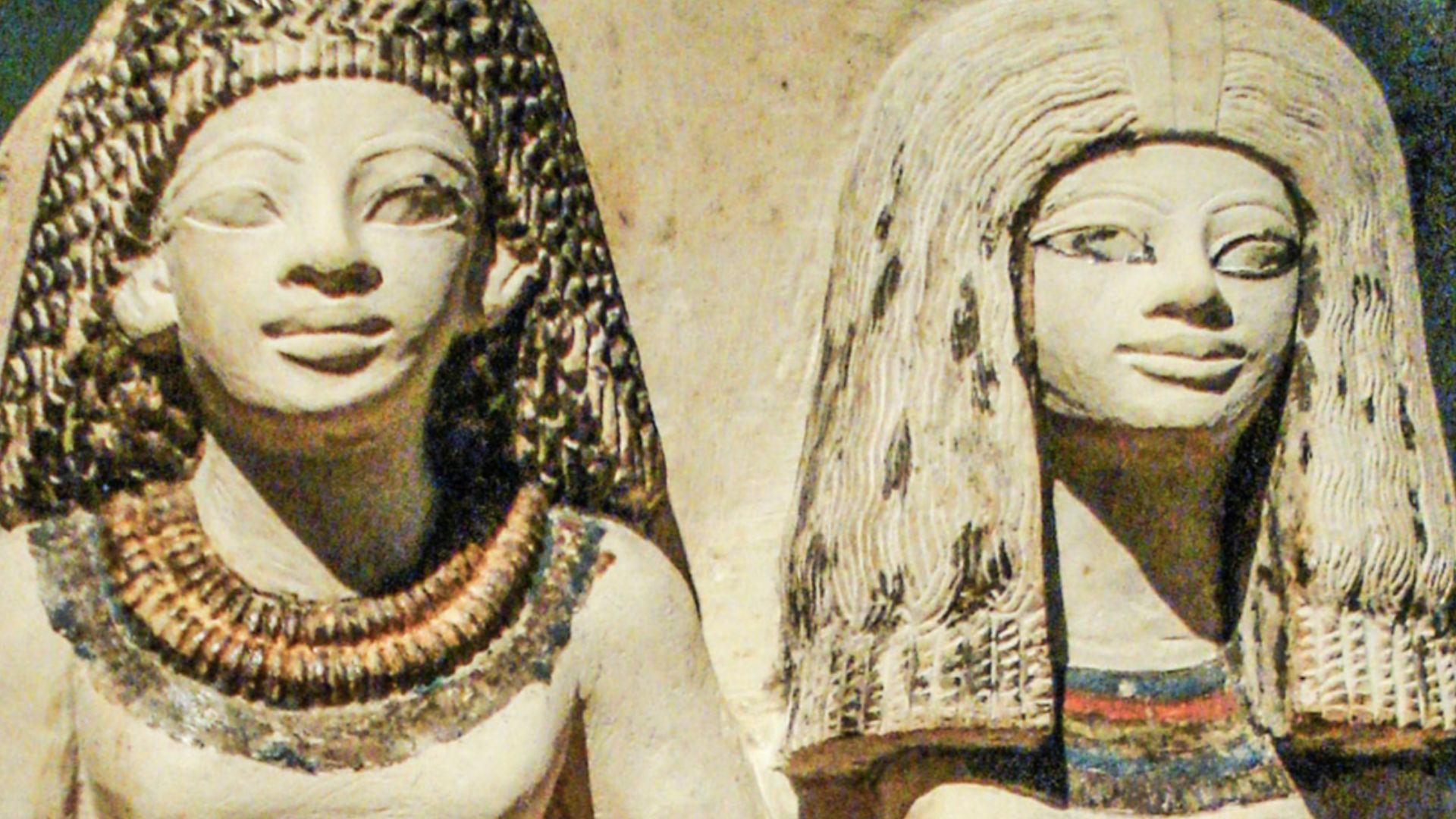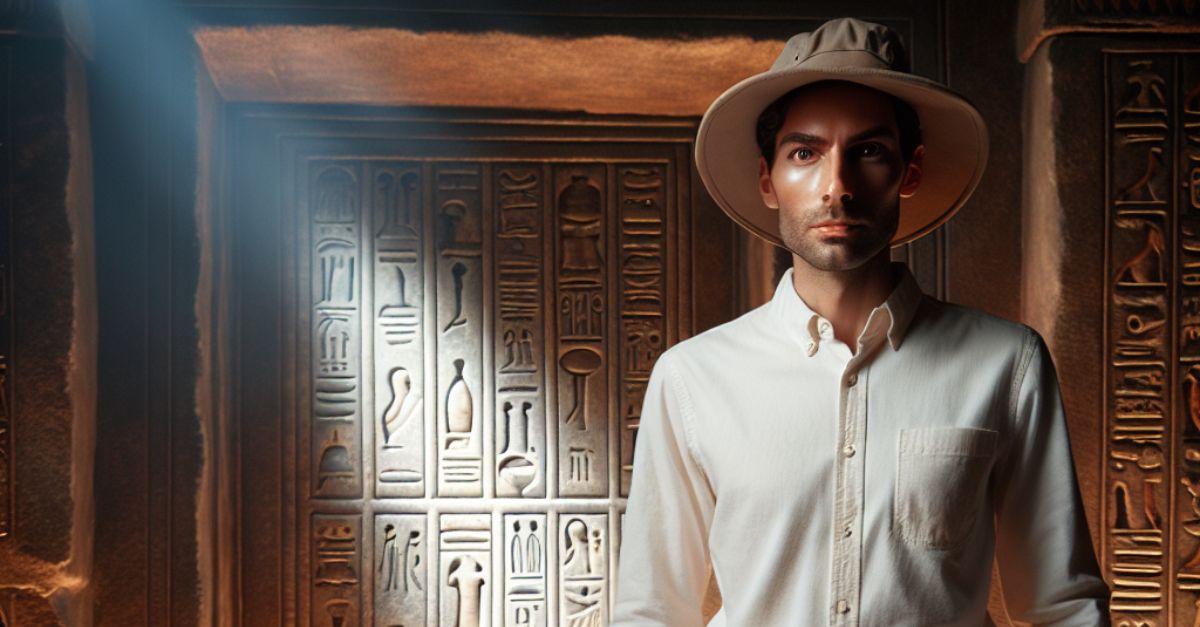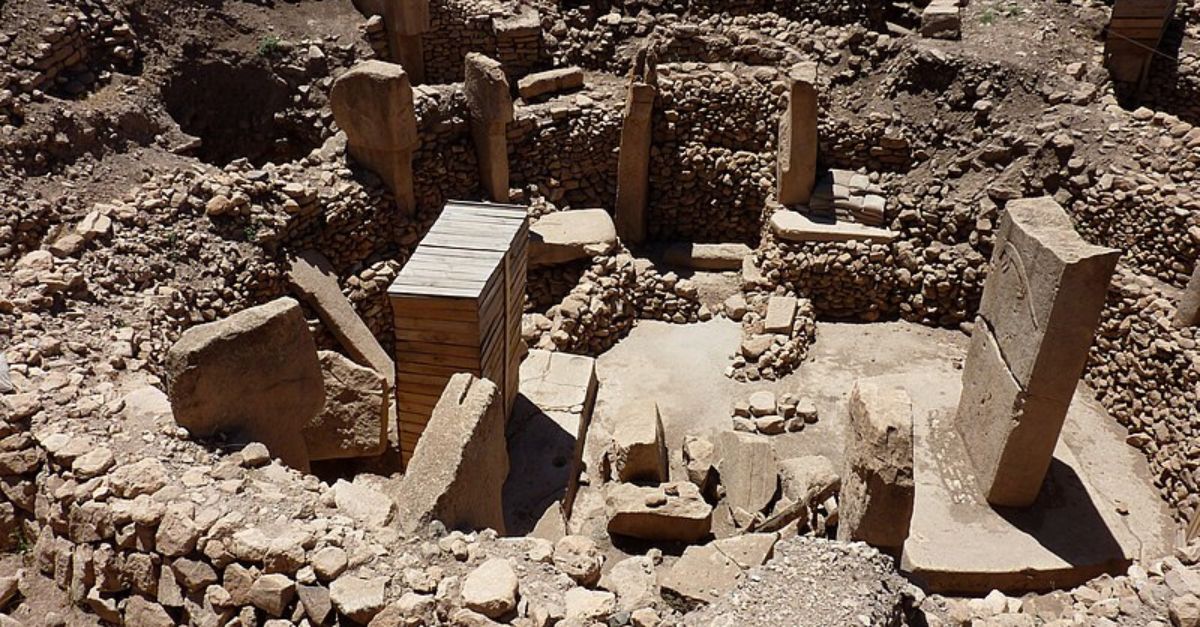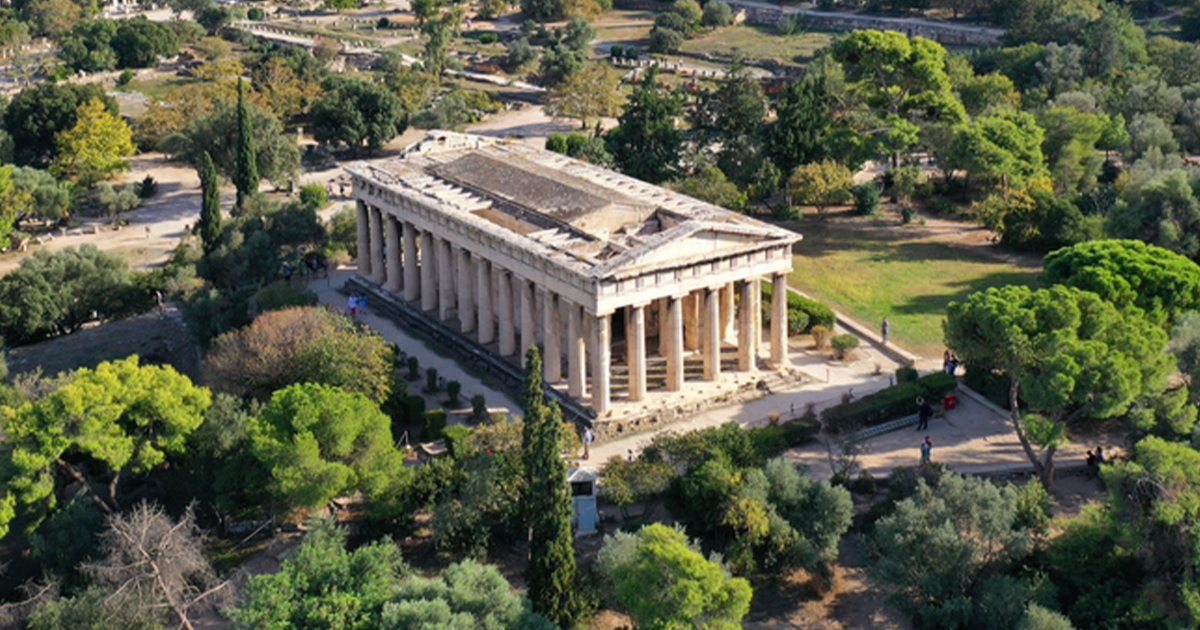The Door That Shouldn't Exist
In a quiet section of Saqqara, excavators uncovered something unexpected—a towering, pink granite door untouched by looters (and time).
A Landmark Find At Saqqara
The tomb was uncovered in a high-ranking burial field near the Pyramid of Unas, deep within Saqqara's southern sector. Archaeologists discovered a pink granite false door—4.5 meters tall and 1.2 meters wide—anchored into one of the best-preserved structures from the Fifth Dynasty.
 Vyacheslav Argenberg, Wikimedia Commons
Vyacheslav Argenberg, Wikimedia Commons
A Landmark Find At Saqqara (Cont.)
Though solid and inoperable by design, the door held profound ritual meaning. It represented a passage for the Ka (the soul) to enter and exit the tomb. Its placement and preservation suggested not only architectural mastery but also an elite reverence for death and a continued spiritual presence.
 Berthold Werner, Wikimedia Commons
Berthold Werner, Wikimedia Commons
Identifying The Tomb's Owner
Inscriptions on the granite elements name Userefre, son of Pharaoh Userkaf. His titles, including "Governor of Nekheb" and "Royal Scribe," tie him directly to the Fifth Dynasty court. These were not ceremonial ranks; they reflected active participation in governance and temple life.
Saqqara's Continued Elite Use In The Fifth Dynasty
Despite the royal cemetery's shift to Abusir—a site near Cairo established by Fifth Dynasty pharaohs—many noble families continued using Saqqara's necropolis, or sacred burial ground. Tombs like this one demonstrate that Saqqara retained its prestige, reinforced by its proximity to the Old Kingdom pyramid complexes.
 Axel Seedorff (de:Benutzer:Aoswch), Wikimedia Commons
Axel Seedorff (de:Benutzer:Aoswch), Wikimedia Commons
Saqqara's Continued Elite Use In The Fifth Dynasty (Cont.)
Abusir housed the sun temples of Userkaf and his successors, yet nobles returned to Saqqara for burial near earlier dynastic kings. Its symbolic weight and established mortuary infrastructure made it a deeply strategic location. It offered association with Egypt's oldest sacred kingship landscape.
Royal Titles Etched In Stone
Userfre's titles appear to be carved directly into the pink granite false door. Phrases like "Chanting Priest" and "Chief of Secrets" suggest deep integration in both religious and political spheres. Their arrangement follows conventions observed in high-ranking tombs from the Fifth Dynasty.
 Fascinating Structure Inside Ancient Tomb:
Fascinating Structure Inside Ancient Tomb:
Royal Titles Etched In Stone (Cont.)
Each title was more than honorific. "Chief of Secrets" referred to control over sacred knowledge, especially temple rites. "Chanting Priest" indicated a liturgical role, likely tied to solar temples. These titles also ensured continued respect in the afterlife, as inscribed roles influenced posthumous offerings made on their behalf.
 Fascinating Structure Inside Ancient Tomb:
Fascinating Structure Inside Ancient Tomb:
Tomb Orientation And Layout Confirm High Rank
The tomb's central axis aligns precisely with the cardinal directions. This orientation, along with axial symmetry and an elaborately structured facade, signals elite planning. Such spatial precision is typical of tombs commissioned for members of the royal family or high-ranking state officials.
 Fascinating Structure Inside Ancient Tomb:
Fascinating Structure Inside Ancient Tomb:
Carved Entirely From Pink Granite
Quarried from Aswan, the pink granite used in this door required long-distance transport and royal-level resources. In the Old Kingdom, such stone was typically restricted to pyramids or high court commissions. Which is why its presence here signals access to elite privileges.
 S. Rae from Scotland, UK, Wikimedia Commons
S. Rae from Scotland, UK, Wikimedia Commons
Carved Entirely From Pink Granite (Cont.)
Transporting granite from Aswan to Saqqara involved river barges and labor teams authorized by the state. Only those with connections to royal quarries could secure such material. The craftsmanship also demonstrates skilled labor, as evidenced by its central oversight and participation in elite construction networks.
 Saran Rengaraj, Wikimedia Commons
Saran Rengaraj, Wikimedia Commons
Discovery Was Spearheaded By The Supreme Council Of Antiquities
The excavation was conducted under the direction of Egypt's Supreme Council of Antiquities. This official body oversees archaeological missions across Egypt. Its mandate includes the preservation, and the public presentation of significant heritage finds such as this Saqqara tomb complex.
Joint Announcement By Waziri And Hawass
Dr Mostafa Waziri and Dr Zahi Hawass announced the Saqqara tomb discovery in April 2025. Waziri spoke on behalf of the Supreme Council of Antiquities, while Hawass directed the excavation. The Ministry of Tourism and Antiquities stressed the tomb’s exceptional preservation and remarkable architectural scale.
 White House photo by Krisanne Johnson, Wikimedia Commons
White House photo by Krisanne Johnson, Wikimedia Commons
Egyptian Team Responsible For Field Excavation
Unlike earlier periods dominated by foreign expeditions, this find was entirely excavated by an Egyptian archaeological team. Their expertise reflects growing national leadership in the preservation and interpretation of their country’s ancient heritage.
Archaeologists Collaborated With Conservation Experts
The project involved collaboration with stone conservation specialists and engineers. Each helped assess the condition of the false door and plan for its long-term protection. Modern conservation practices were applied throughout the excavation and stabilization phases of the project.
 Santabiblia, Wikimedia Commons
Santabiblia, Wikimedia Commons
International Scholars Provided Remote Analysis
Although the fieldwork remained domestic, several international Egyptologists were consulted for their interpretive insights. Scholars from European and North American institutions contributed remote analyses of architectural parallels and inscriptional conventions to help contextualize the findings within the broader context of Old Kingdom funerary practice.
The Ministry Of Tourism And Antiquities Supported The Discovery
Funding and public outreach were supported by Egypt's Ministry of Tourism and Antiquities. This partnership ensures that archaeological projects contribute to heritage education and tourism development by aligning scientific discovery with cultural diplomacy and national economic goals.
Positioned To Receive Daily Offerings
Archaeologists identified a flat area in front of the door where ritual activity occurred. Its placement aligns with traditional offering practices, and inscriptions name specific goods—bread, beer, oxen, and fowl—required for the tomb owner's eternal sustenance.
Inscriptions Follow Old Kingdom Funerary Formulae
The false door bears the hetep di nesu formula, a standard invocation found in the tombs of the elite of the Fifth Dynasty. This formula requests offerings from the gods on behalf of the deceased and reflects shared beliefs in divine provisioning beyond death.
 Egypt discovers untouched tomb in the ancient necropolis of Saqqara by euronews
Egypt discovers untouched tomb in the ancient necropolis of Saqqara by euronews
Tool Marks Reveal Copper Chisel Usage
Microscopic analysis of the granite's surface reveals shallow grooves and strike patterns consistent with hammered copper chisels. These tools, widely used in Old Kingdom quarries, were capable of shaping even dense granite through repeated blows, but the process was slow and required skilled hands.
 CHILLING MESSAGES ENCODED in Egyptian Tombs | Secrets of Ancient Egypt by HISTORY
CHILLING MESSAGES ENCODED in Egyptian Tombs | Secrets of Ancient Egypt by HISTORY
Installation Required Sledges And Lubrication Techniques
After river transport, granite pieces were hauled overland using wooden sleds. Water or oil was poured onto the sand to reduce friction, a method confirmed by wall reliefs in the tomb of Djehutihotep. Teams coordinated to maneuver the door slab into place without breakage.
Joined Without Mortar Using Tight-Fitting Precision
The false door was installed flush with the surrounding limestone. Ancient builders shaved and fitted stone manually until joints became nearly invisible. No mortar was used—a technique reserved for high-status structures requiring durability and symbolic permanence.
 Fascinating Structure Inside Ancient Tomb:
Fascinating Structure Inside Ancient Tomb:
Dimensions Suggest A Custom Commission
Designs aligned with Fifth Dynasty funerary standards often required the approval of high-ranking officials. This door's unmatched scale points to a custom order for Userefre's burial. Measuring 4.5 by 1.2 meters, its dimensions do not correspond with those of reused elements, which confirms that it was crafted specifically for this tomb.
An Offering Table Discovered Near The Door
A red granite offering table stood directly before the false door, placed to receive ritual items for the deceased. Its location and composition mirror Old Kingdom traditions, where such tables functioned as focal points for food offerings to nourish the spirit of the tomb owner.
 Intrusive Burial Found Inside Egyptian Noble’s Tomb! | Expedition Unknown by Discovery
Intrusive Burial Found Inside Egyptian Noble’s Tomb! | Expedition Unknown by Discovery
Statues Of Wives Found Nearby
Thirteen seated statues, carved from pink granite, were arranged beside the false door. Their positioning and similar seated posture suggest intentional grouping. Scholars interpret them as depictions of Userefre's wives, each rendered with unique facial features to reflect individuality and status within the prince's household.
Statues Of Wives Found Nearby (Cont.)
Although inscriptions are damaged, partial names like Meretites and Nebet suggest ties to known noblewomen. Each statue shows subtle stylistic differences in hair and garment folds. Their grouping remains one of the most intact representations of elite consorts found in Old Kingdom tomb architecture.
 One dead president, David Liam Moran, Wikimedia Commons
One dead president, David Liam Moran, Wikimedia Commons
Depictions Of Family Confirm Social Rank
Elite tombs often displayed family members to emphasize lineage and social reach. The number and scale of female statues within this tomb reinforce Userefre's high status. Their presence likely served to assert legitimacy and prestige both in life and after death.
 Intrusive Burial Found Inside Egyptian Noble’s Tomb! | Expedition Unknown by Discovery
Intrusive Burial Found Inside Egyptian Noble’s Tomb! | Expedition Unknown by Discovery
Artifacts Suggest Later Reuse
A black granite statue with stylistic features from the 26th Dynasty was discovered within the tomb's confines. This suggests reoccupation centuries later, a pattern seen across Saqqara, where older tombs were repurposed for new elite burials or shrine functions under later dynasties.
 Leon petrosyan, Wikimedia Commons
Leon petrosyan, Wikimedia Commons
Other Royal Statues Present
Archaeologists recovered statue fragments believed to represent King Djoser's family. One bears royal emblems matching his reign. Others reflect feminine attributes tied to queenship and youth. Their reuse in this tomb shows how Saqqara's burial grounds evolved across dynasties to blend past reverence with later adaptations.
 Panegyrics of Granovetter, Wikimedia Commons
Panegyrics of Granovetter, Wikimedia Commons
Nobility Maintained Royal Mortuary Rituals
Userefre's tomb followed practices typically reserved for kings. The architectural symmetry and liturgical inscriptions mirror royal tombs from the same era. These details show how noble burials extended pharaonic traditions and preserved religious continuity within the elite class.
 Warren LeMay from Chicago, IL, United States, Wikimedia Commons
Warren LeMay from Chicago, IL, United States, Wikimedia Commons
Role Of The Ka In Egyptian Funerary Practice
Egyptians believed the Ka—the vital spirit—remained in the tomb and needed nourishment. False doors served as spiritual thresholds. Through them, offerings could pass symbolically into the afterlife by ensuring the Ka received food and ritual gestures meant to sustain it for eternity.
 Juan R. Lazaro, Wikimedia Commons
Juan R. Lazaro, Wikimedia Commons
Solar Symbolism Linked To Fifth Dynasty Rulers
The tomb's alignment and use of sunlit granite reflect beliefs tied to solar theology. Userefre's father, Userkaf, established Egypt's first sun temples. Tomb features echo this tradition and link Userefre's eternal journey to the solar cycle and divine kingship.
Axial Symmetry Marks Elite Planning
This design helped integrate earthly ritual flow with spiritual transition in the afterlife. It mirrored cosmic order by aligning architecture with divine principles. The tomb's central axis, which runs directly from the entrance to the false door, followed a pattern seen in Old Kingdom tombs reserved for high-ranking individuals.
 Intrusive Burial Found Inside Egyptian Noble’s Tomb! | Expedition Unknown by Discovery
Intrusive Burial Found Inside Egyptian Noble’s Tomb! | Expedition Unknown by Discovery
Use Of Limestone And Granite Together
Builders selected local Saqqara limestone for the structural body and imported granite for symbolic features. This deliberate pairing emphasized function and meaning. Granite marked spiritual thresholds, such as the false door, while limestone handled architectural loads to mirror material hierarchies seen in royal tomb complexes.
 Panegyrics of Granovetter, Wikimedia Commons
Panegyrics of Granovetter, Wikimedia Commons
Wall Reliefs Are Absent But Consistent With Elite Tombs
No wall reliefs decorate the tomb's inner surfaces, but this absence is not unusual. Fifth Dynasty non-royal tombs often prioritized stone inscriptions and statuary over pictorial narratives. Inscriptions here play a similar role in preserving identity and instructing rituals rather than illustrating daily life.
 Fascinating Structure Inside Ancient Tomb:
Fascinating Structure Inside Ancient Tomb:
Drainage Design Implies Long-Term Preservation Intent
Carefully laid stone channels beneath the floor help divert water runoff. This feature highlights the importance of forethought in achieving architectural longevity. Comparable systems at other elite tombs demonstrate that preserving structural integrity and ritual function were important long after the burial took place.
Fifth Dynasty Saw Rise Of Provincial Tombs
As Egypt's central authority expanded, so did its elite administration. Princes and officials were granted burial privileges outside royal cemeteries. Userefre's tomb fits this pattern—its autonomy and scale reflect the decentralization that marked the Fifth Dynasty's evolving mortuary landscape.
 Intrusive Burial Found Inside Egyptian Noble’s Tomb! | Expedition Unknown by Discovery
Intrusive Burial Found Inside Egyptian Noble’s Tomb! | Expedition Unknown by Discovery
Non-Pharaonic Tombs Grew More Monumental
The Fifth Dynasty saw non-royal elites building tombs with materials and layouts once reserved for kings. And Userefre's tomb demonstrates this shift from restricted royal privilege to selective elite inclusion. Pink granite and formal inscriptions began to appear in the tombs of high officials.
Similar Tombs Found In Abusir And Giza
Tombs near the pyramids of Abusir and Giza show architectural parallels with Userefre's resting place. These include false doors and granite statuary—standard features in elite burials. Such consistency highlights an emerging architectural vocabulary shared across noble tombs of the Fifth Dynasty.
 Petar Milosevic, Wikimedia Commons
Petar Milosevic, Wikimedia Commons
3D Scanning Revealed Chisel Work Details
Researchers utilized 3D laser scanning to examine the granite surface at an ultra-high resolution. The scans revealed parallel scoring marks and fine tool impressions that were invisible to the bare eye. These patterns allowed archaeologists to reconstruct carving techniques used by Old Kingdom craftsmen.
 360° Travel inside the Great Pyramid of Giza - BBC by BBC
360° Travel inside the Great Pyramid of Giza - BBC by BBC
Environmental Conditions Helped Preserve The Door
Saqqara's arid climate and sand-filled burial preserved the false door's carvings. Minimal groundwater exposure and the absence of seasonal flooding meant that delicate inscriptions remained legible. Unlike other tombs, erosion here was limited, which allowed the monument to remain in exceptional condition.
 Vyacheslav Argenberg, Wikimedia Commons
Vyacheslav Argenberg, Wikimedia Commons
Stratigraphy Confirms Uninterrupted Use
Excavators documented clear stratigraphic layers above the tomb, free of intrusive pits or looting shafts. The continuity of fill materials suggests no significant disruption occurred between its original sealing and later reuse, a rare pattern in tombs of this age at Saqqara.
Preservation Adds Rare Insight Into Stone Craft
Due to its pristine condition, this false door presents a rare opportunity to study Fifth Dynasty stone carving in situ, meaning at its original location. Its incision depth and polishing detail preserve direct evidence of ancient artistry, rarely visible in surviving tombs across Saqqara.
 Carole Raddato from FRANKFURT, Germany, Wikimedia Commons
Carole Raddato from FRANKFURT, Germany, Wikimedia Commons
Why Was It Ultimately Abandoned?
Despite its grandeur, the tomb shows signs of repurposing or incomplete use. A sealed shaft remains unopened, and burial evidence is missing. Scholars suggest dynastic turnover or logistical delays may have halted its original funerary function during or after construction.
 Intrusive Burial Found Inside Egyptian Noble’s Tomb! | Expedition Unknown by Discovery
Intrusive Burial Found Inside Egyptian Noble’s Tomb! | Expedition Unknown by Discovery
Burial Chamber Status Remains Unconfirmed
As of the latest reports in April 2025, the status of the burial chamber remains unclear. No confirmed access to the shaft has been reported, and details regarding skeletal remains or grave goods are still unknown and await further excavation by the archaeological team on site.
 Intrusive Burial Found Inside Egyptian Noble’s Tomb! | Expedition Unknown by Discovery
Intrusive Burial Found Inside Egyptian Noble’s Tomb! | Expedition Unknown by Discovery





















